Charles E W Bean, Diaries, AWM38 3DRL 606/119A/1 - Photostats - Part 1
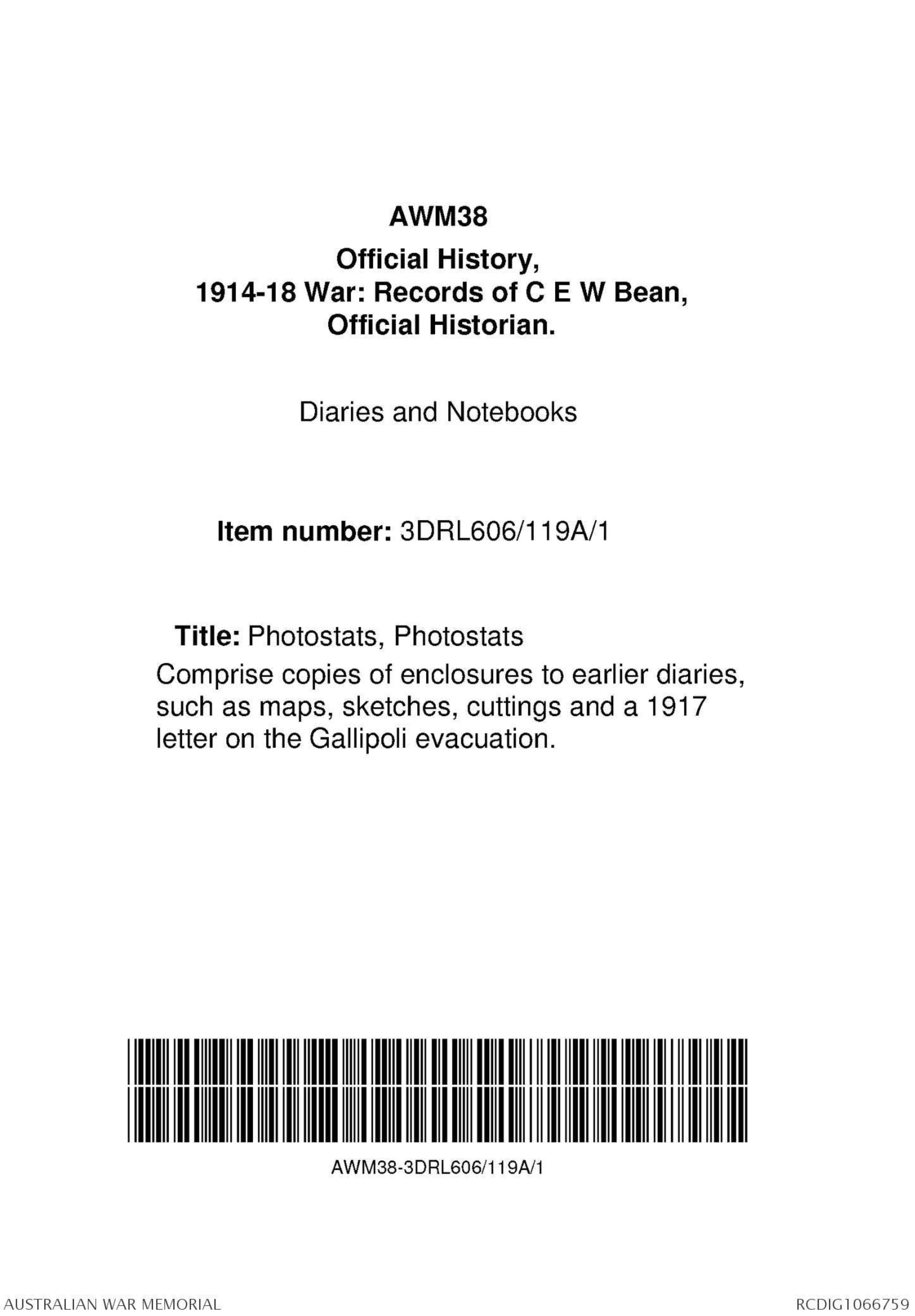
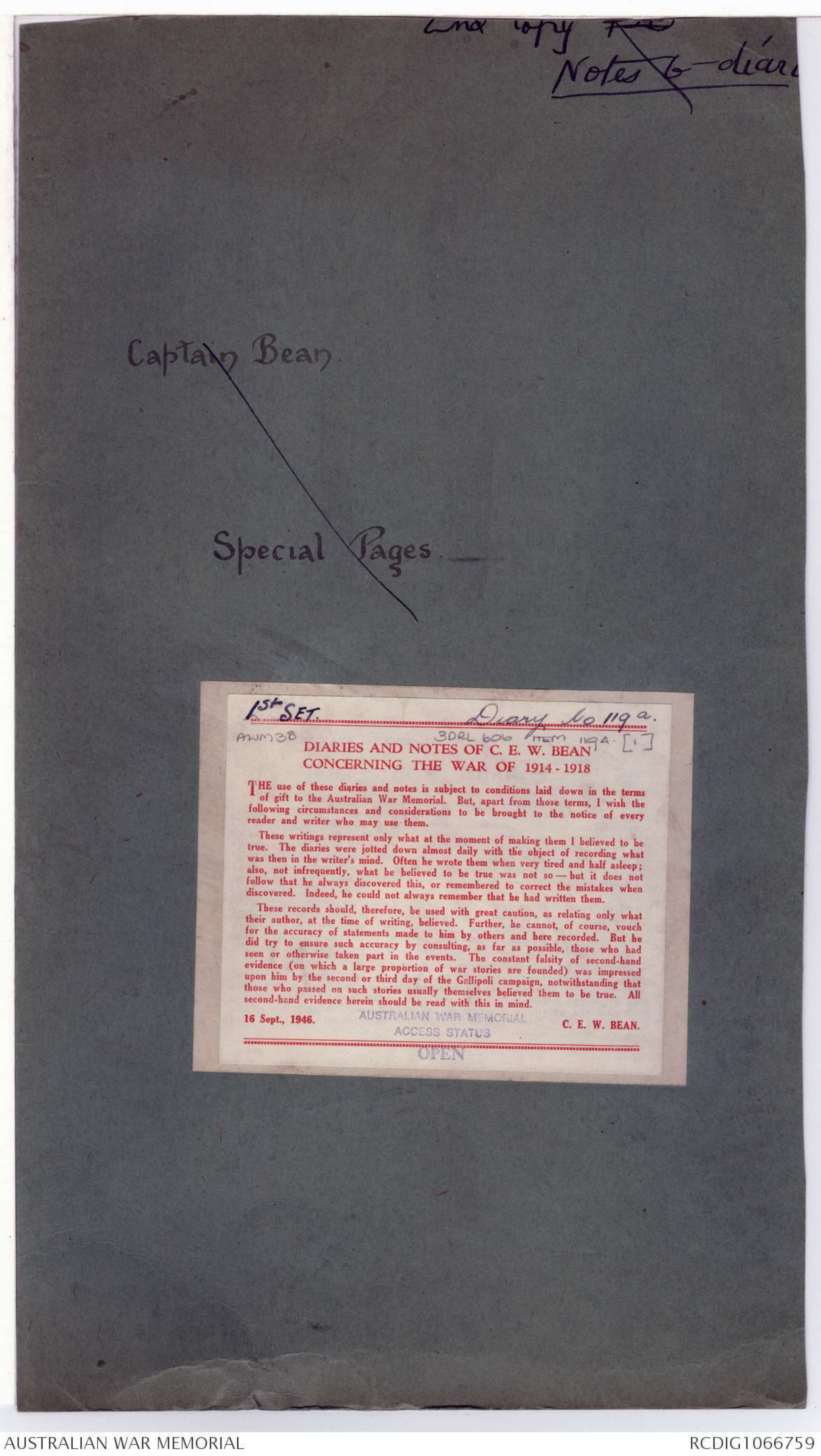
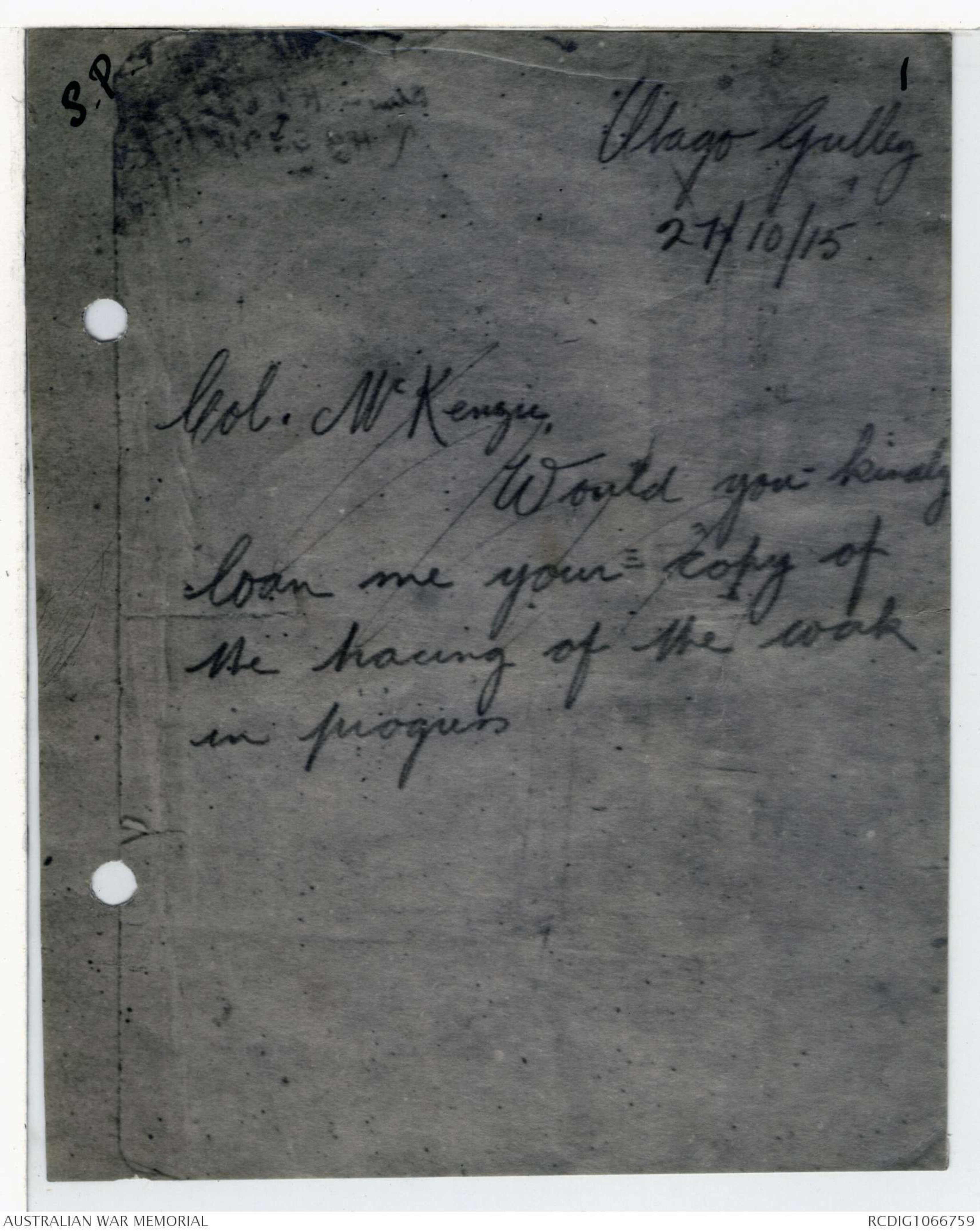
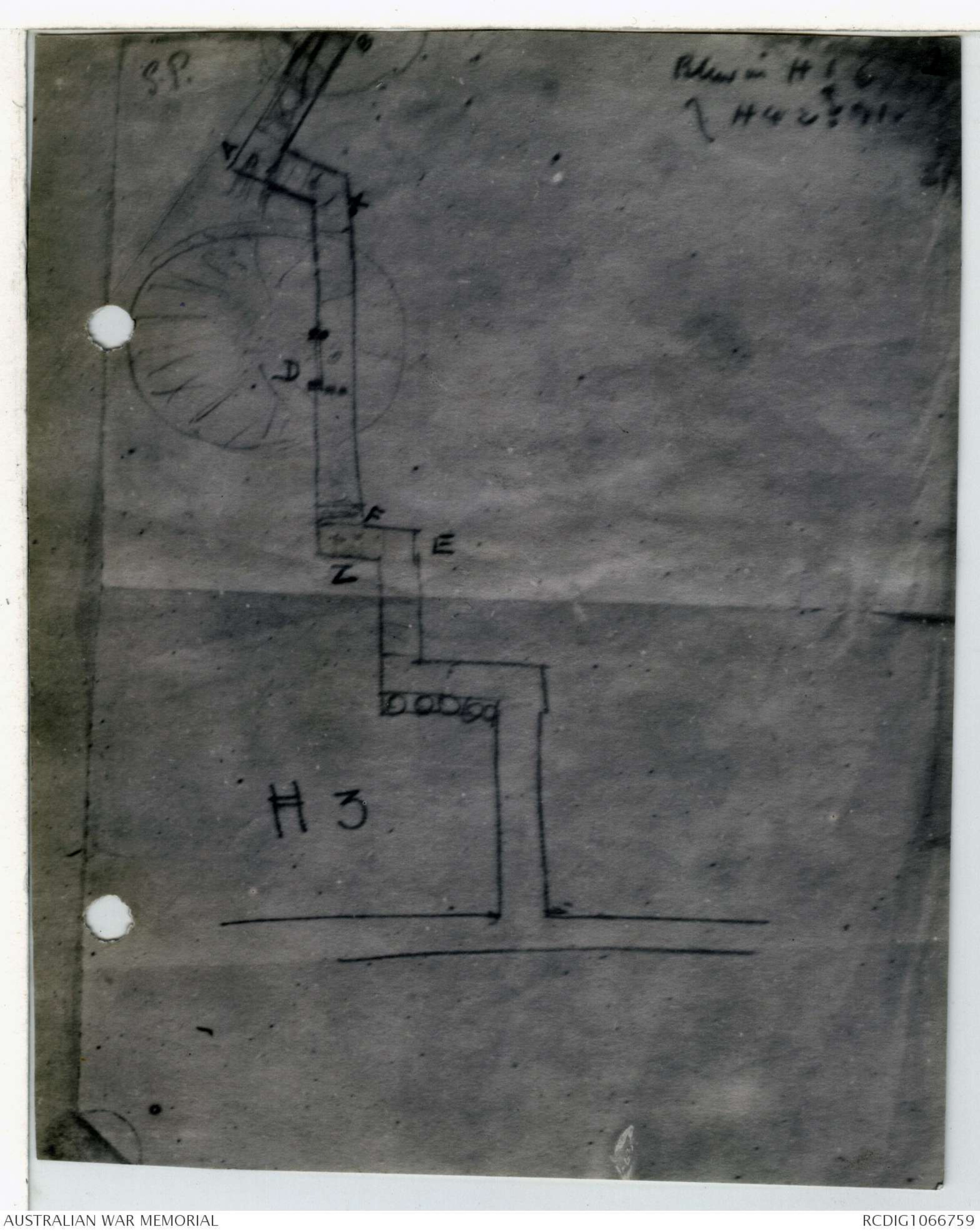
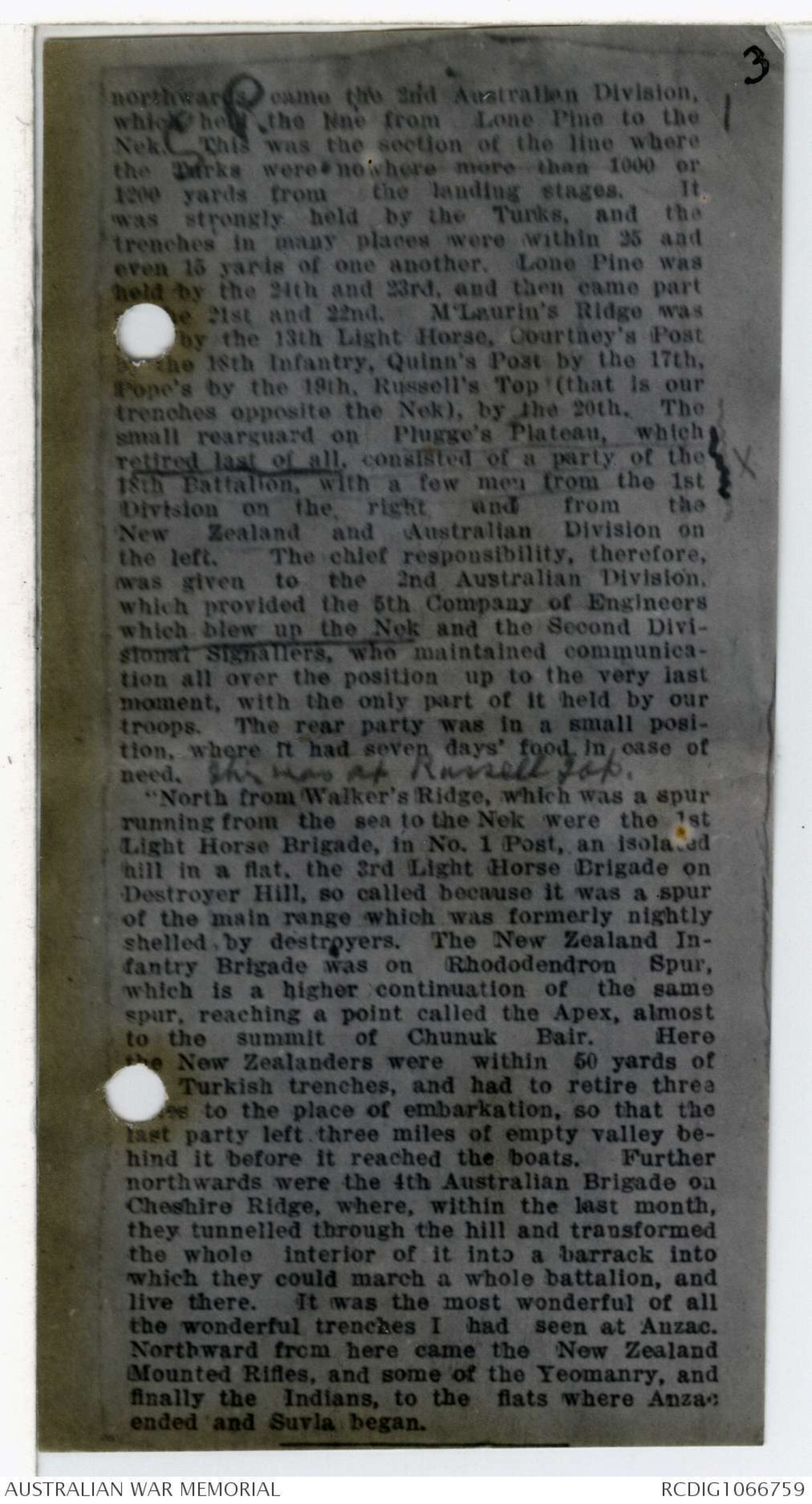
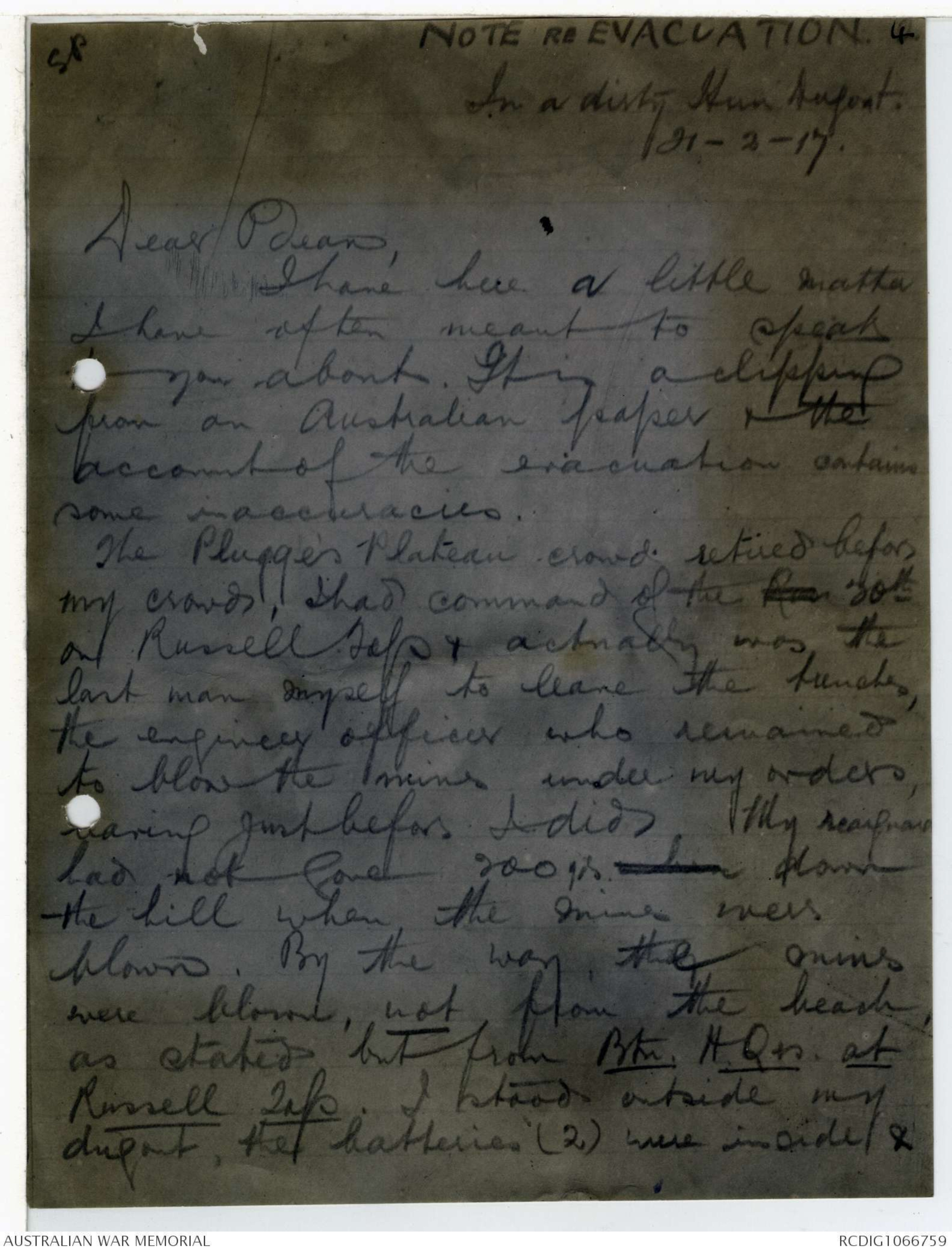
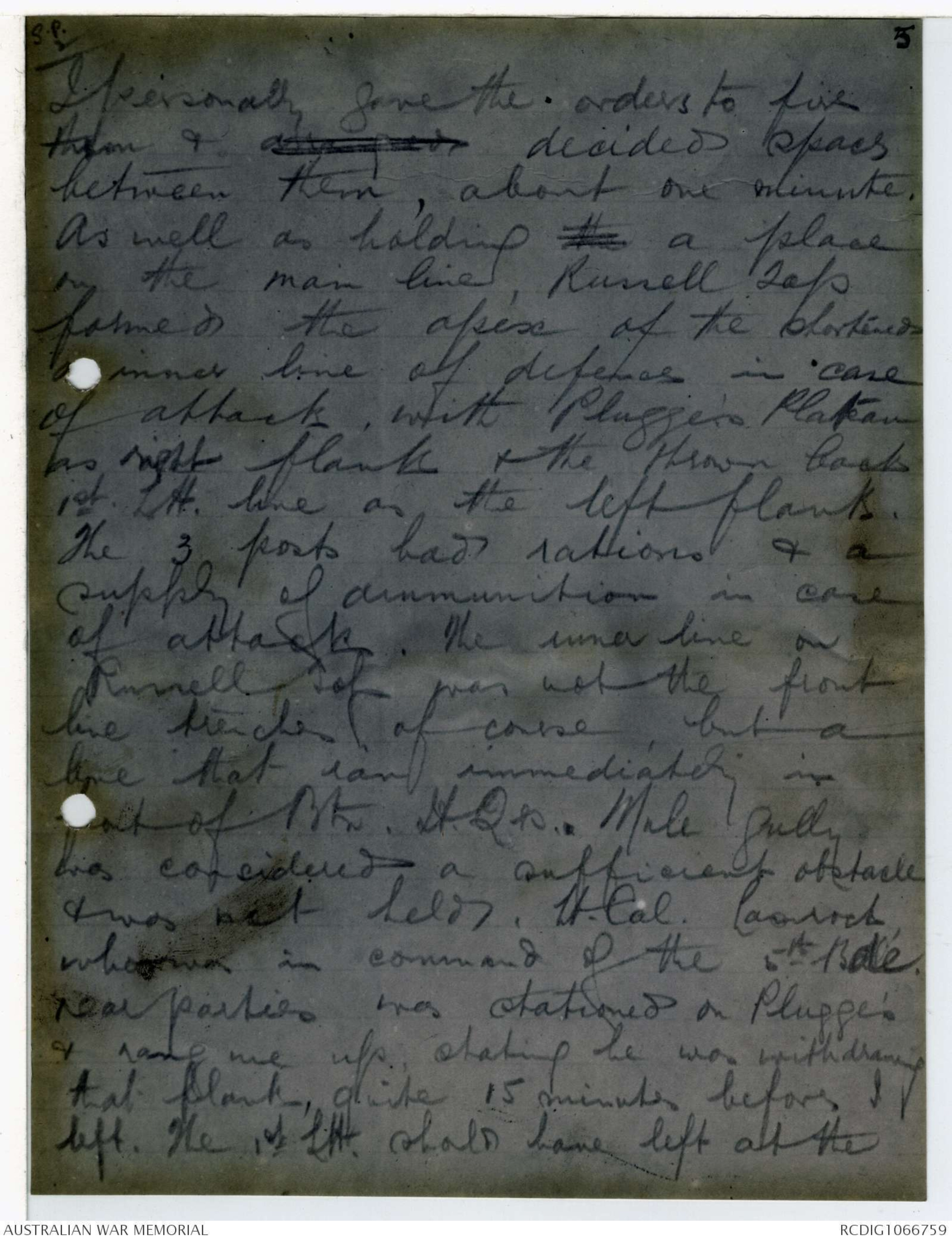
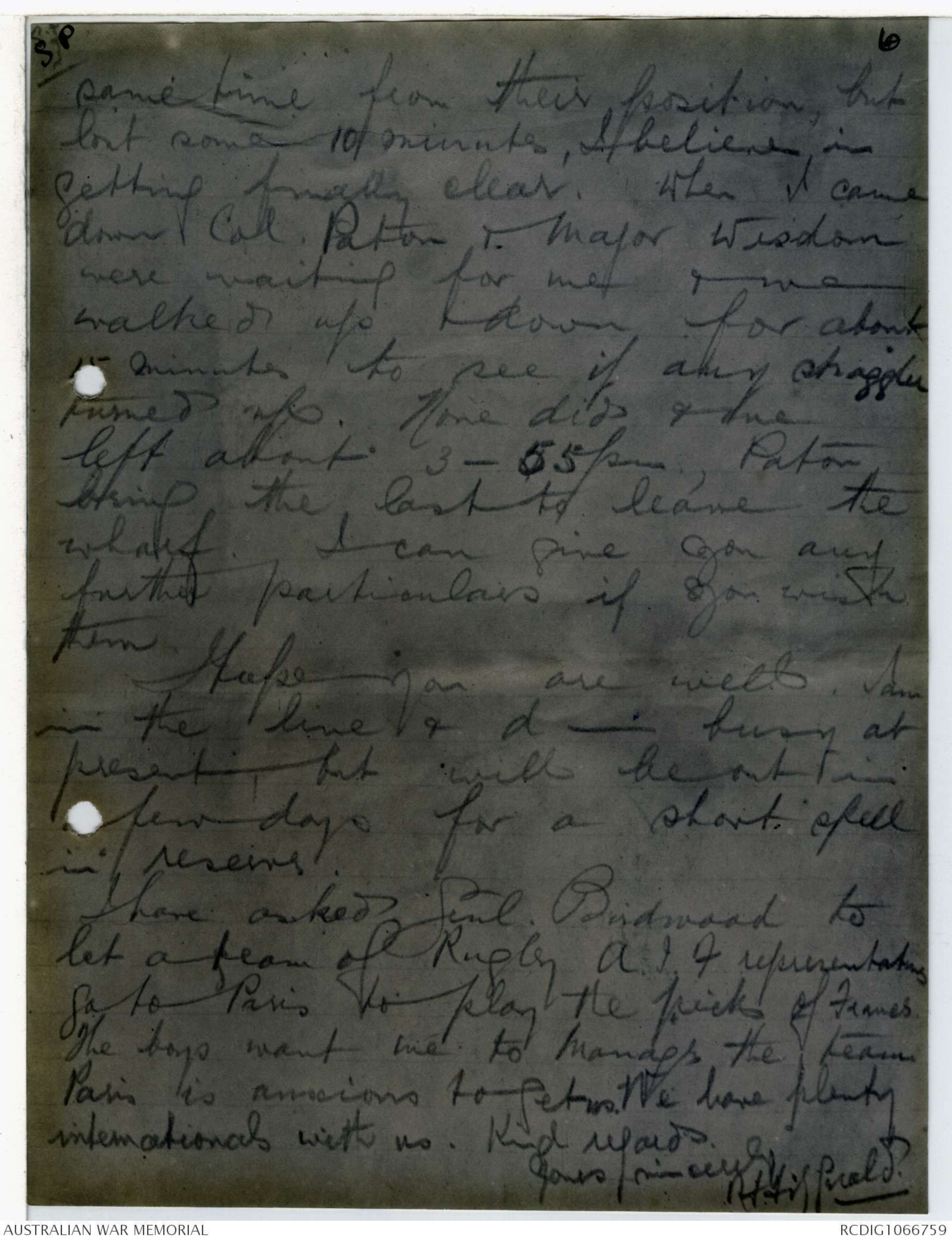
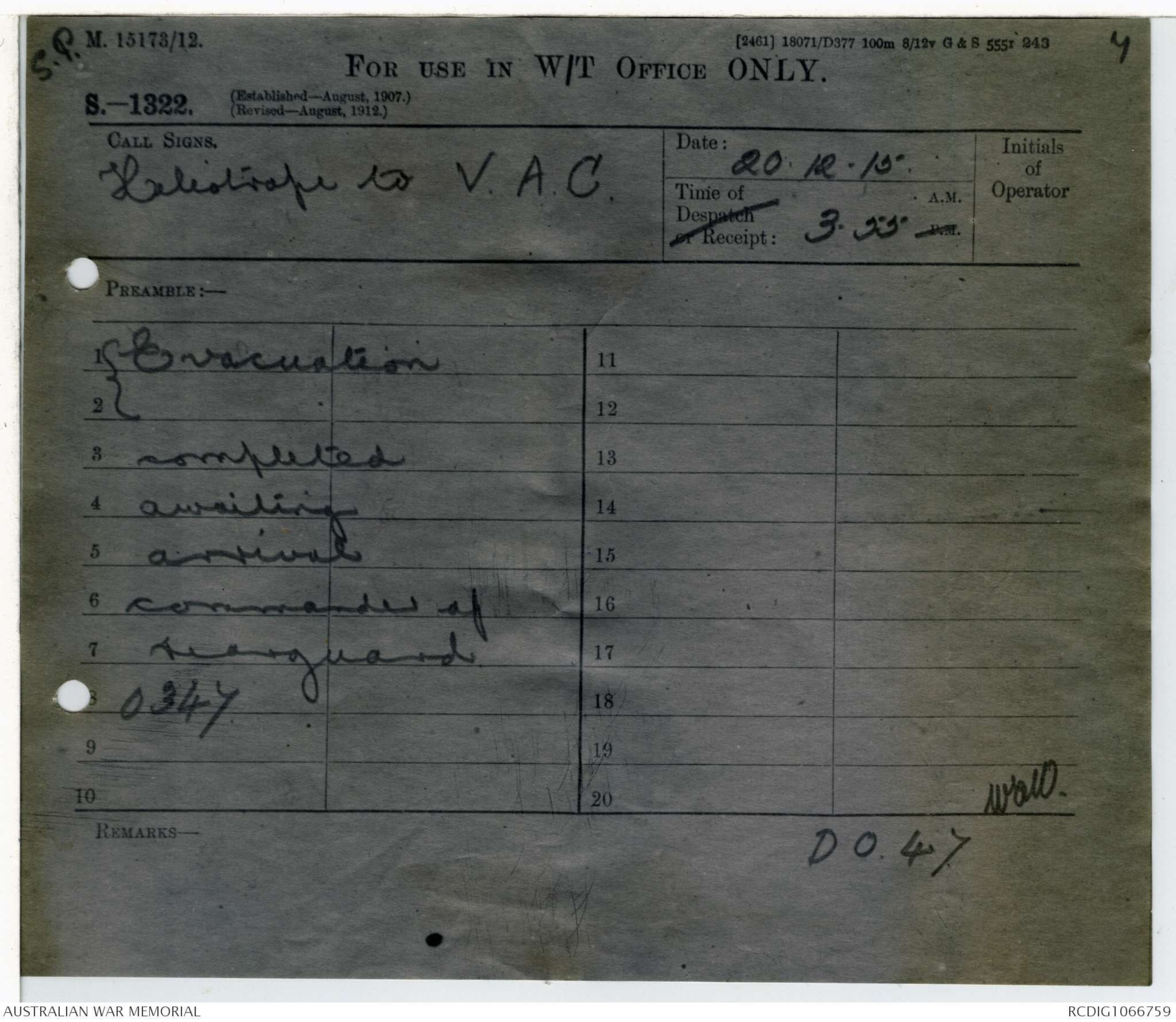
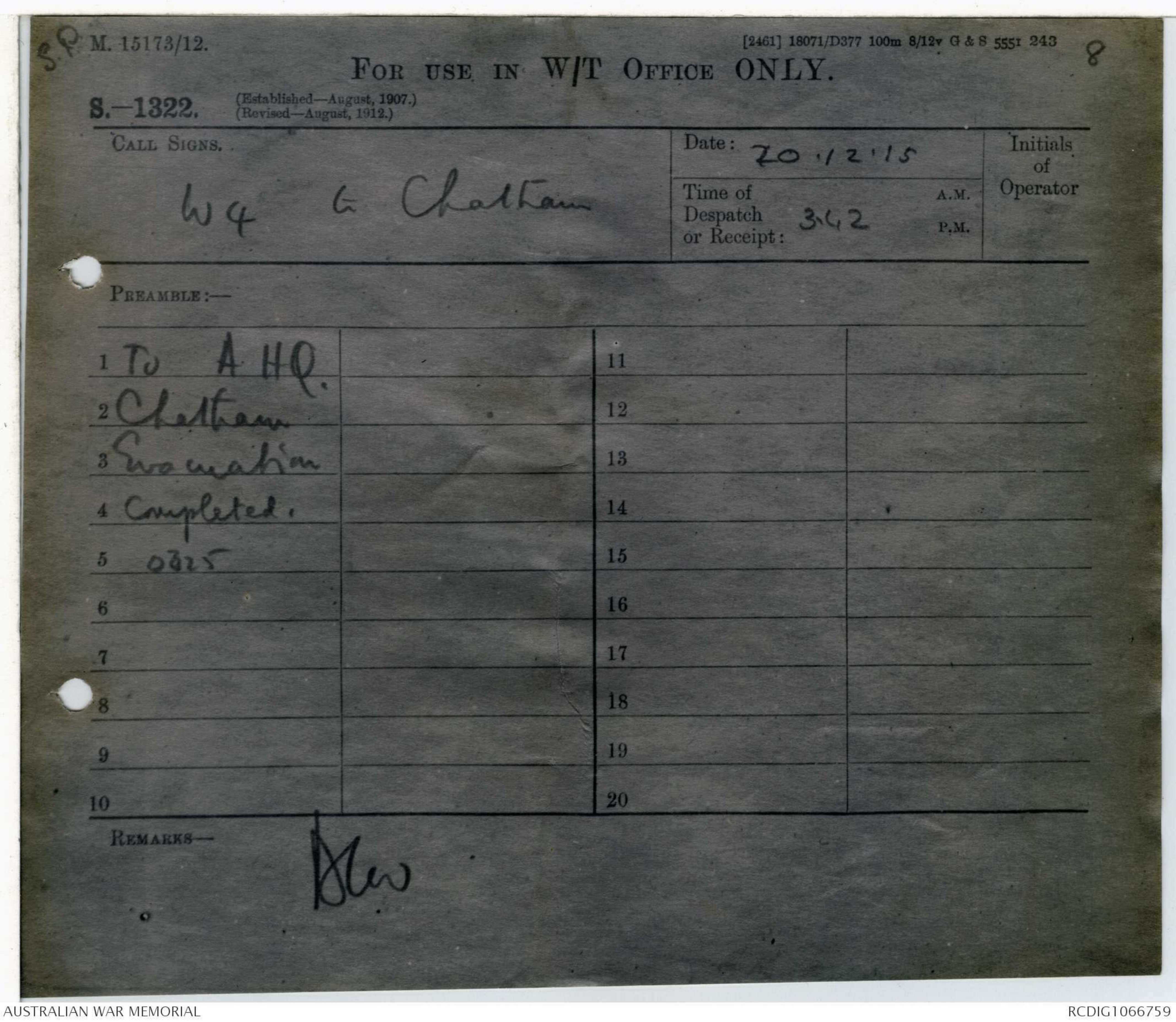
AWM38
Official History,
1914-18 War: Records of C E W Bean,
Official Historian.
Diaries and Notebooks
Item number: 3DRL606/119A/1
Title: Photostats, Photostats
Comprise copies of enclosures to early diaries,
such as maps, sketches, cuttings and a 1917
letter on the Gallipoli evacuation.
AWM38-3DRL606/119A/1
2nd copy xx
Notes to diary
Captain Bean.
Special Pages
1st Set Diary No 119a.
AWM38 3DRL 606 ITEM 119A [1]
DIARIES AND NOTES OF C. E. W. BEAN
CONCERNING THE WAR OF 1914 - 1918
THE use of these diaries and notes is subject to conditions laid down in the terms
of gift to the Australian War Memorial. But, apart from those terms, I wish the
following circumstances and considerations to be brought to the notice of every
reader and writer who may use them.
These writings represent only what at the moment of making them I believed to be
true. The diaries were jotted down almost daily with the object of recording what
was then in the writer's mind. Often he wrote them when very tired and half asleep;
also, not infrequently, what he believed to be true was not so - but it does not
follow that he always discovered this, or remembered to correct the mistakes when
discovered. Indeed, he could not always remember that he had written them.
These records should, therefore, be used with great caution, as relating only what
their author, at the time of writing, believed. Further, he cannot, of course vouch
for the accuracy of statements made to him by others and here recorded. But he
did try to ensure such accuracy by consulting, as far as possible, those who had
seen or otherwise taken part in the events. The constant falsity of second-hand
evidence (on which a large proportion of war stories are founded) was impressed
upon him by the second or third day of the Gallipoli campaign, notwithstanding that
those who passed on such stories usually themselves believed them to be true. All
second-hand evidence herein should be read with this in mind.
16 Sept., 1946.
C. E. W. BEAN.
AUSTRALIAN WAR MEMORIAL
ACCESS STATUS
OPEN
S.P 1
Otago Gully
27/10/15
Col. McKenzie,
Would you kindly
loan me your copy of
the tracing of the work
in progress
Hand drawn diagram – see original
S.P. 3
northwards came the 2nd Australian Division,
which held the line from Lone Pine to the
Nek. This was the section of the line where
the Turks were nowhere more than 1000 or
1200 yards from the landing stages. It
was strongly held by the Turks, and the
trenches in many places were within 25 and
even 15 yards of one another. Lone Pine was
held by the 24th and 23rd, and then came partxxx the 21st and 22nd. McLaurin's Ridge wasxxx by the 13th Light Horse, Courtney's Post
by the 18th Infantry, Quinn's Post by the 17th,
Pope's by the 19th. Russell's Top (that is our
trenches opposite the Nek), by the 20th. The
small rearguard on Plugge's Plateau, which
retired last of all, consisted of a party of the X
18th Battalion, with a few men from the 1st
Division on the right and from the
New Zealand and Australian Division on
the left. The chief responsibility, therefore,
was given to the 2nd Australian Division,
which provided the 5th Company of Engineers
which blew up the Nek and the Second Divisional
Signallers, who maintained communication
all over the position up to the very last
moment, with the only part of it held by our
troops. The rear party was in a small position,
where it had seven days' food in case of
need. This was at Russell Top.
"North from Walker's Ridge, which was a spur
running from the sea to the Nek were the 1st
Light Horse Brigade, in No. 1 Post, an isolated
hill in a flat, the 3rd Light Horse Brigade on
Destroyer Hill, so called because it was a spur
of the main range which was formerly nightly
shelled by destroyers. The New Zealand In-
fantry Brigade was on Rhododendron Spur,
which is a higher continuation of the same
spur, reaching a point called the Apex, almost
to the summit of Chunuk Bair. Here
the New Zealanders were within 50 yards ofxxx Turkish trenches, and had to retire threexxx to the place of embarkation, so that the
last party left three miles of empty valley be-
hind it before it reached the boats. Further
northwards were the 4th Australian Brigade on
Cheshire Ridge, where, within the last month,
they tunnelled through the hill and transformed
the whole interior of it into a barrack into
which they could march a whole battalion, and
live there. It was the most wonderful of all
the wonderful trenches I had seen at Anzac.
Northward from here came the New Zealand
Mounted Rifles, and some of the Yeomanry, and
finally the Indians, to the flats where Anzac
ended and Suvla began.
SP NOTE RE EVACUATION 4
In a dirty Hun Dugout.
21-2-17.
Dear Bean
I have here a little matter
I have often meant to speak
to you about. It is a clipping
from an Australian paper & the
account of the evacuation contains
some inaccuracies.
The Plugge's Plateau crowd retired before
my crowds, I had command of the Men 20th
on Russell Top & actually was the
last man myself to leave the trenches,
the engineer officer who remained
to blow the mines under my orders,
leaving just before I did. My rearguard
had not gone 200 yds when down
the hill when the mines were
blown. By the way, the mines
were blown, not from the beach
as stated but from Btn. HQrs. at
Russell Top. I stood outside my
dugout, the batteries (2) were inside &
S.P. 5
2
I personally gave the orders to fire
them & arranged decided spaces
between them, about one minute.
As well as holding the a place
on the main line, Russell Top
formed the apex of the shorlinesxxx inner line of defences in case
of attack, with Plugge's Plateau
as right flank & the thrown back
1st LH. line as the left flank.
The 3 posts had rations & a
supply of ammunition in case
of attack. The inner line on
Russell Top was not the front
line trenches of course, but a
line that ran immediately in
front of Btn. H. Qrs. Mule Gully
was considered a sufficient obstacle
& was not held. Lt. Col. Lamrock,
who was in command of the 5th Bde.
rear parties was stationed on Plugge's
& rang me up, stating he was withdrawing
that flank, quite 15 minutes before I
left. The 1st LH. should have left at the
SP 6
same time from their position, but
lost some 10 minutes, I believe in
getting finally clear. When I came
down Col. Paton & Major Wisdom
were waiting for me & we
walked up & down for about
15 minutes to see if any stragglers
turned up. None did & we
left about 3-55 pm. Paton
being the last to leave the
wharf. I can give you any
further particulars if you wish
them.
I hope you are well. I am
in the line & d — busy at
present, but will be out inxxx few days for a short spell
in reserve.
I have asked Genl. Birdwood to
let a team of Rugby A.I.F. representatives
go to Paris to play the picks of France.
The boys want me to manage the team
Paris is anxious to get us. We have plenty
internationals with us. Kind regards
Yours sincerely
RF Fitzgerald
S.P.
7
M. 15173/12.
[2461] 18071/D377 100m 8/12v G & S 555r 243
FOR USE IN W/T OFFICE ONLY.
S.1322. (Established-August, 1907.)
(Revised-August, 1912.)
| CALL SIGNS. Heliotrope to V.A.C. |
Date: 20.12.15 _____________________________ |
Initials of Operator |
PREAMBLE:-
| 1.{Evacuation | 11 | ||
| 2.{ | 12 | ||
| 3. completed | 13 | ||
| 4. awaiting | 14 | ||
| 5. arrival | 15 | ||
| 6. commander of | 16 | ||
| 7. rearguard | 17 | ||
| 8. 0347 | 18 | ||
| 9. | 19 | ||
| 10. | 20 |
REMARKS—
WAW.
DO.47
S.P.
8
M. 15173/12.
[2461] 18071/D377 100m 8/12v G & S 555r 243
S-1322
FOR USE IN W/T OFFICE ONLY.
CALL SIGNS.
W4 to Chatham
Date: 20-12-15
Time of
Despatch
or Receipt: 3.42 A.M. P.M.
Initials of Operator
PREAMBLE:-
To AHQ.
Chatham
Evacuation
Completed
03.25
REMARKS—
DCW
 Loretta Corbett
Loretta CorbettThis transcription item is now locked to you for editing. To release the lock either Save your changes or Cancel.
This lock will be automatically released after 60 minutes of inactivity.